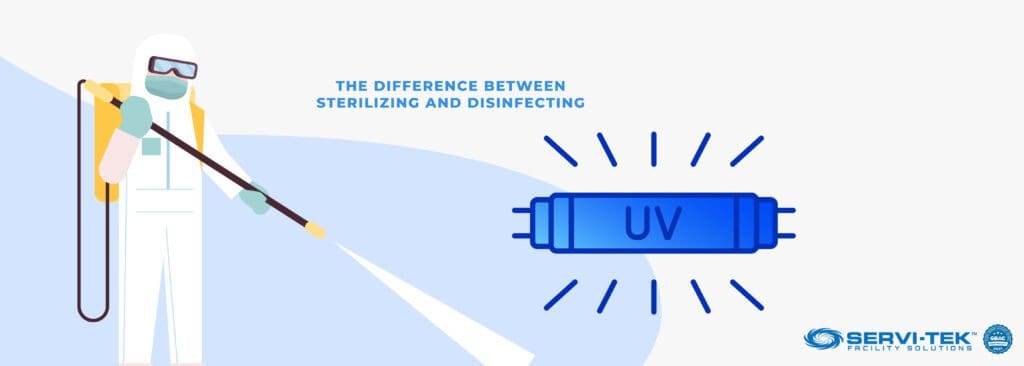
In the world of infection control, the terms cleaning, disinfecting, and sterilizing are often used interchangeably, leading to confusion about which procedures to use and when. While they all aim to make a space safer, they accomplish this at different levels of effectiveness. Understanding the distinctions is a crucial first step in creating a truly hygienic and healthy environment for your commercial property.
This guide explains the key differences between these three processes and guides their proper application for combating dangerous microorganisms.
Defining the Three Levels of Infection Control

The key takeaway is this: you must always clean a surface before you disinfect it. Disinfectants are ineffective on dirty surfaces because grime and organic matter can protect germs from the chemical agents.
Disinfecting vs. Sterilizing: Where to Use Each Method
The choice between disinfecting and sterilizing depends heavily on your facility and industry.
Disinfecting is the most common method for day-to-day infection control in commercial settings. It is essential for high-touch surfaces in common areas, such as:
- Doorknobs, handrails, and light switches
- Countertops, desks, and tabletops
- Electronic devices like keyboards and touchscreens
- Restroom handles and soap dispensers
Broad-spectrum disinfectants, approved by the EPA’s List N, are the standard for commercial use, as they are effective against a wide range of pathogens.
Sterilizing, on the other hand, is a much more rigorous process reserved for environments where a zero-tolerance policy for microbial life is required. This is typically used in:
- Healthcare and hospital settings: For surgical instruments, medical devices, and other items that come into contact with skin, blood, or bodily fluids.
- Laboratories: For sterilizing equipment and containers to prevent contamination of experiments.
Standard sterilization methods include high-temperature steam in an autoclave, radiation, and specialized chemical solutions that destroy the nucleic acid of all pathogens. The World Health Organization (WHO) provides comprehensive guidelines on sterilization methods in healthcare settings.
Disinfecting vs. Sterilizing: Where to Use Each Method
Why a Professional Approach to Infection Control Matters
Implementing a proper infection control plan involves more than simply understanding the differences between cleaning, disinfecting, and sterilizing.
- Expertise and Safety: Professional cleaning crews are trained in the correct use of chemicals and equipment to ensure effectiveness and safety. They know the correct “dwell time” for disinfectants and use proper PPE, reducing the risk of injury or chemical exposure.
- Healthy Employees and Clients: A professional approach significantly reduces the spread of germs, which can lower employee absenteeism and keep both your staff and customers safe. This is especially important in high-traffic facilities where a single sick person can quickly infect many others.
- Tailored Solutions: A reputable commercial cleaning company will work with you to create a customized plan based on your facility’s specific needs, objectives, and industry regulations. They have access to the best equipment, including advanced methods such as electrostatic disinfection, to ensure the job is done right. For more information, please refer to our article on Electrostatic Disinfection Services.
By partnering with an industry leader, you can eliminate concerns about infection control details and focus on your core business, knowing that your facility is clean, safe, and protected.




